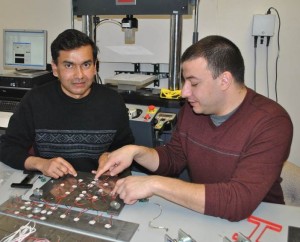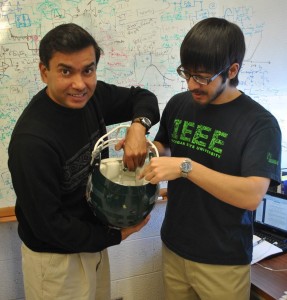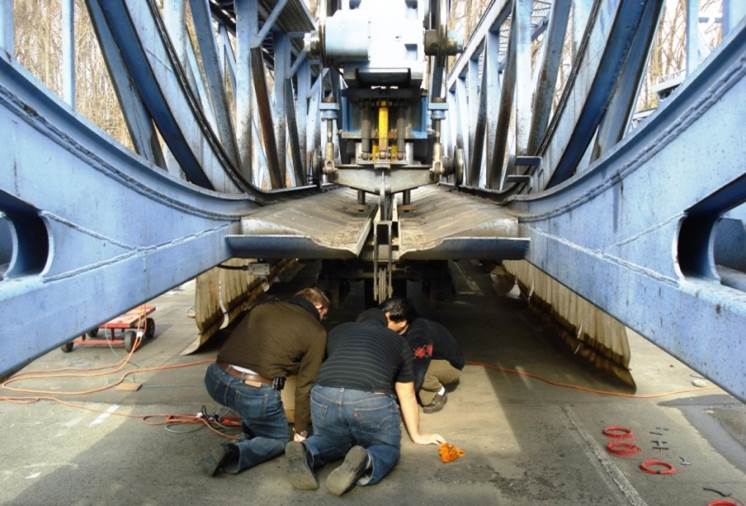Structural failure is a clear danger in the US. More than 60,000 bridges are deficient, and 33 percent of roads are in poor or mediocre conditions. Scientists are attempting to monitor conditions on various bridges, dams, and roads using sensors that detect mechanical stress. However, the sensors currently in use have significant limitations: Not only do they rely on external power sources such as batteries, but their large size and need for frequent maintenance greatly restricts their sensitivity and practicality in the field. To break these barriers, Shantanu Chakrabartty from Michigan State University (MSU) has developed self-sustaining sensors. What he has accomplished in creating an efficient, practical technology could revolutionize infrastructure, diagnostic medicine, and beyond.

For the past decade, Chakrabartty has been working at MSU to improve sensor technology. His primary research area is developing self-sustaining sensors that can identify mechanical failures. Chakrabartty invented a new type of sensor that utilizes natural processes and converts them into detectable electrical triggers. These environmental processes include stress and strain by wind, traffic, and pressure. The sensors can detect, compute, and store data of natural processes without the aid of a battery or external power source. This means the sensors can be miniaturized to the size of a dime and can be placed in convenient locations.
The core science behind these sensors is piezoelectricity, or electricity generated from mechanical stress. When nearby mechanical processes put strain on a sensor, piezoelectric circuits within that sensor use a transducer to convert the strain signal into an electrical signal. After amplifying the signal, the sensor can log various events that are sufficiently large, such as an expanding crack in infrastructure.
Chakrabartty and members of his lab, the Adaptive Integrated Microsystems Laboratory at MSU, set out to build sensors that are fully self-powered, and that are more sensitive in their detection of mechanical stress. First, they investigated their target structures to gather essential information about mechanical processes that put daily stress on bridges, dams, and the like. With this information in mind, the team created piezoelectric impact ionized hot-electron injection (p-IHEI) sensors that can extract data from these sources of mechanical energy.
Next, Chakrabartty increased the power of his sensors. Now, not only were the sensors self-sustaining, but they could detect frequencies up to millions of times smaller than those detected by current technology. They could also measure forces thousands of times weaker than the force of gravity, which is essential for detecting miniscule changes in infrastructure before it spirals into disaster. Chakrabartty’s group used a specialized elastic strip, which connects to the transducer. As strain is applied, the elastic properties of the strip cause it to vibrate in a certain fashion. This vibration then causes a stream of high-energy electrons to enter the transducer at a much higher intensity, essentially concentrating the signal. Chakrabartty’s method not only increases the strength of the reading, but also dramatically decreases the amount of energy leakage from piezoelectric sensors.
Only 15 millimeters wide, these devices can be placed almost anywhere. They could be paved into roads, placed on steel beam and suspension cables on bridges, attached to the blades of wind turbines. To access these sensors and collect data, researchers can send out an ultrasound signal from a variety of devices, including their own smartphones. They would be able to detect and monitor changes in real time, diagnose any potential problems in infrastructure, and send warning signals for any imminent catastrophe. Chakrabartty envisions a world where “smart” structures containing many of these small sensors are continually gathering feedback data.

“Smart” structures are not the only application that Chakrabartty sees for his self-powered sensors. The microscopic size of these sensors means they could be useful for medical purposes as well, especially when it comes to efficient diagnosis. Sensors could be placed inside the body, in joints, bones, or even heart valves, or could be used in prosthetics. Chakrabartty would also like to see the sensors embedded in “smart” sports helmets to automatically diagnose concussions. With the ability to sense collision data and accurately analyze the resulting damage, this technology would not only make diagnosis faster and more reliable, but would also be cost-effective and compatible with technology already used by health care professionals.
But first, Chakrabartty must perfect the design of these embedded self-powered sensors. To achieve this, he cofounded Piezonix, a start-up company, in 2013. His team has won numerous awards, including the 2014 Silicon Valley Startup Business Competition Grand Prize and the National Science Foundation Small Business Technology Award. With another patent currently pending, the team is making great strides to make this technology more feasible, affordable, and efficient.
Chakrabartty’s vision of a world with smart devices that automatically store information may become a reality because of his own invention. The failing bridges and roads in the US and around the world could use this technology to monitor themselves and send out warnings before disaster strikes. Removing the need for external power allows for fully independent devises well-suited for a broad range of applications, from infrastructure to the human body and beyond. Although this self-powered sensor technology is new and still young, it looks holds extreme promise for the future.
Cover Image: Self-powered sensors may be attached to or embedded inside bridges, pavements, vehicles, rotating parts, and biomedical implants. There are far-reaching implications to Chakrabartty’s research, some of which are already being explored. Image courtesy of Shantanu Chakrabartty.

